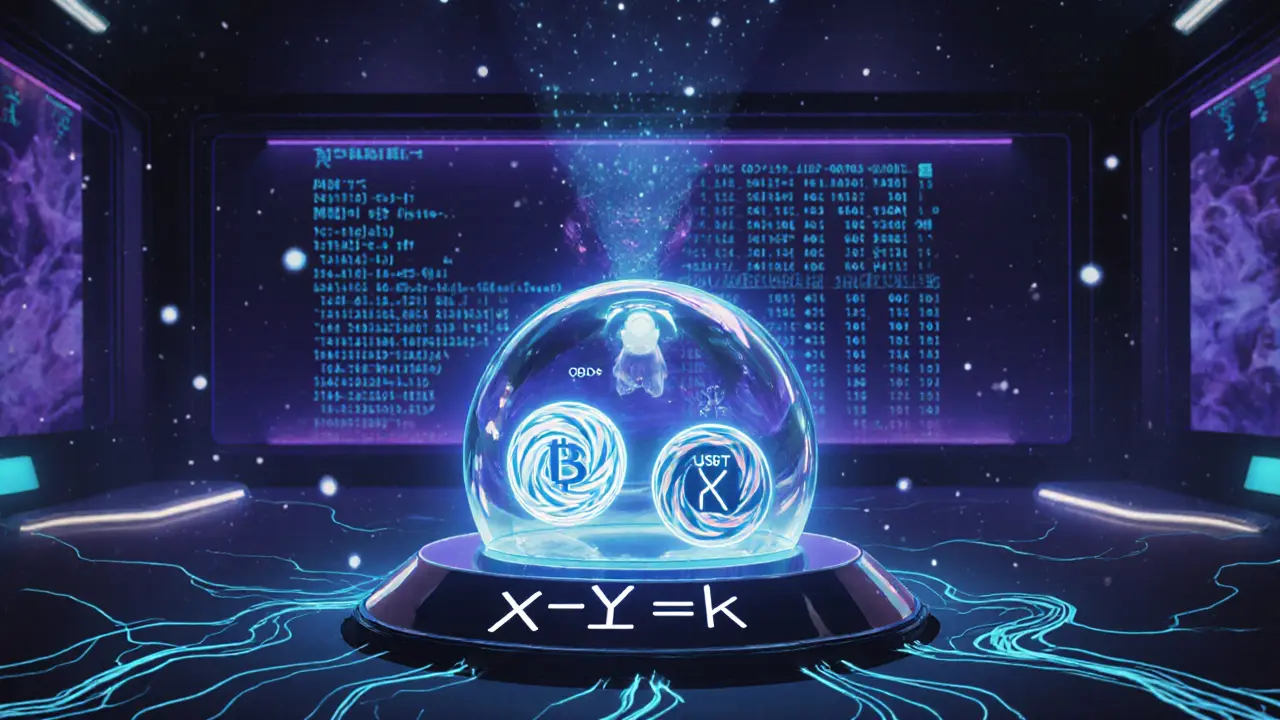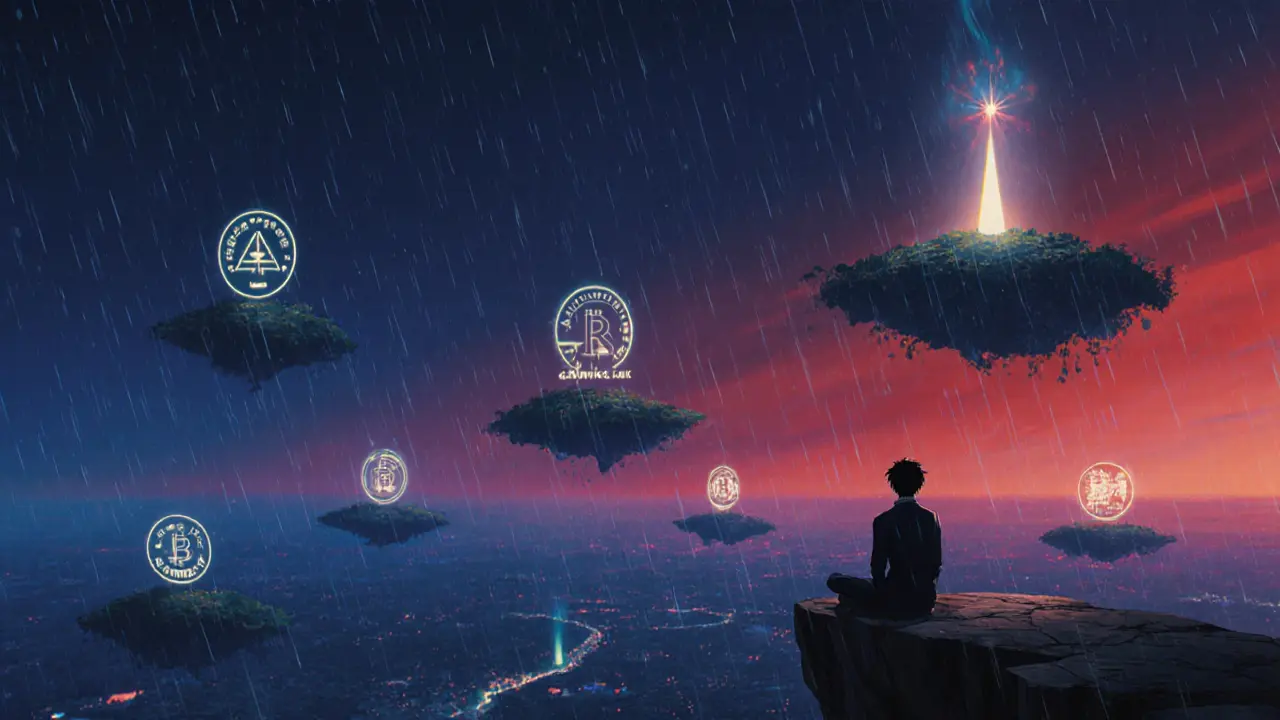Ordiswap Liquidity Calculator
Ordiswap Liquidity Calculator
Estimated Returns
Total Value Deposited:
Pool Ownership:
Daily Fee Earnings:
Annual Earnings:
Ordiswap (ORDS) is a decentralized automated market maker (AMM) protocol built for Bitcoin’s BRC‑20 token standard. Launched in December 2023, it aims to bring true DeFi liquidity to Bitcoin’s native layer by marrying BRC‑20 tokens with Ordinals technology. In plain English, Ordiswap lets you swap Bitcoin‑based tokens without a centralized order book, using the same pool‑based math that powers Uniswap on Ethereum.
Quick Takeaways
- Ordiswap operates as a native BRC‑20 AMM on Bitcoin, the first of its kind.
- Total supply is capped at 1 billion ORDS; about 60‑70% is already circulating.
- All‑time high price was $0.2816 (Mar 5 2024); current price hovers around $0.001.
- Liquidity is spread across six exchanges, with ORDS/USDT contributing ~52% of volume.
- Medium‑term technical indicators are mildly bullish, but the token remains highly volatile.
Technical Architecture
Ordiswap’s core innovation is the off‑chain AMM engine that settles trades on Bitcoin using BRC‑20 inscriptions. The protocol does not rely on smart contracts in the Ethereum sense; instead, it encodes token balances and pool states into Bitcoin transaction metadata, leveraging the Ordinals protocol to give each token a unique identifier. This design allows the AMM to function while respecting Bitcoin’s limited scripting capabilities.
Key components include:
- Liquidity Pools: Each pool holds a pair of BRC‑20 tokens (e.g., ORDS/USDT). The constant‑product formula (x·y = k) determines prices.
- Oracle Layer: A decentralized off‑chain oracle fetches price data and timestamps, then writes the updated state to Bitcoin as an Ordinal inscription.
- Front‑End Interface: Web‑based UI interacts with the oracle via REST endpoints, letting users add/remove liquidity or swap tokens.
By keeping the heavy lifting off‑chain, Ordiswap sidesteps Bitcoin’s transaction‑size limits and still offers near‑instant swaps.
Token Economics (ORDS)
The ORDS token serves three purposes:
- Governance: Holders can vote on protocol upgrades and fee adjustments.
- Liquidity Incentives: Stakers earn a share of swap fees proportional to their contribution.
- Utility: ORDS can be used as a fee‑payment token on the platform, offering a discount compared to paying with USDT.
Supply details (as of October 2025):
| Total supply | 1 billion ORDS |
| Circulating supply | ≈ 600 million (≈ 60‑70% of total) |
| Contract address | 0x8AB2…52B83c |
| Number of holders | 12,430 |
Most of the supply entered circulation during the seed‑funding round and early liquidity mining programs. No token burn mechanism is currently announced.
Market Performance
ORDS experienced a classic hype‑followed‑by‑correction cycle. After debuting at a penny‑level price, the token vaulted to an all‑time high of $0.2816 on March 5 2024, buoyed by the broader BRC‑20 bull run. Since then, it has shed over 99% of that peak, settling between $0.0008885 and $0.001042 across major exchanges.
Key metrics:
- Current market cap: $555 k - $630 k (depends on data source).
- Fully diluted market cap: $578 k - $940 k.
- 24‑hour volume: $30 k - $312 k, with occasional spikes up to $78 k for the ORDS/USDT pair.
- Price volatility: daily swings of -2.33% to +7.69%.
Technical sentiment stays marginally bullish: the 50‑day SMA ($0.000975) sits above the 200‑day SMA ($0.000805), and the 14‑day RSI is at 59.8, indicating the token is not yet oversold.
How to Acquire and Trade ORDS
ORDS is listed on six exchanges, the most liquid being Bilaxy, MXC, Gate.io, and BitKan. The ORDS/USDT market accounts for roughly half of all trading activity.
- Create a wallet that supports BRC‑20 inscriptions. Options include Ordinals‑aware browsers or dedicated BRC‑20 wallets.
- Deposit Bitcoin (BTC) to fund the wallet. The wallet will automatically generate the corresponding BRC‑20 token addresses.
- Place a market or limit order on any of the supported exchanges. For lower slippage, use the ORDS/USDT pair and check the order book depth.
- Consider liquidity provision. By supplying ORDS and a stablecoin to a pool, you earn a share of swap fees (typically 0.3% per trade).
- Secure your holdings. Transfer tokens back to a hardware wallet or a cold storage solution that can store Ordinals.
Remember that BRC‑20 transactions can be slower and more expensive than Ethereum ERC‑20 swaps, especially during peak Bitcoin network congestion.

Competitive Landscape
Ordiswap is not alone in the Bitcoin DeFi arena. Several projects target the same niche, each with a slightly different approach.
| Feature | Ordiswap | DotSwap | Orders Exchange | BitPerp |
|---|---|---|---|---|
| Model | AMM (pool‑based) | AMM (pool‑based) | Order‑book | Perpetuals & Leverage |
| Native Token | ORDS | DOTS | ORDR | BP |
| Liquidity Focus | Liquidity mining incentives | Standard fee‑share | Depth via order‑book | Funding rate incentives |
| Launch Date | Dec 2023 | Jan 2024 | Feb 2024 | Mar 2024 |
| Current TVL (approx.) | $1.2 M | $0.8 M | $0.5 M | $1.0 M |
Ordiswap’s AMM orientation gives it a smoother user experience for casual traders, while competitors like Orders Exchange cater to power users who prefer price‑level control.
Risks and Outlook
Investing in ORDS carries several risk factors:
- Market Volatility: Price swings of > 90% from peak to trough are common in the BRC‑20 space.
- Technical Constraints: Bitcoin’s limited scripting means upgrades are hard to implement; any protocol bug could require a hard fork.
- Regulatory Uncertainty: Authorities worldwide are still defining rules for Bitcoin‑based DeFi products.
- Adoption Challenge: With only ~12 k holders, network effects are modest compared to Ethereum DEXes.
Analysts at CoinCodex project a short‑term dip to $0.000802 by year‑end 2025, but a 2026 range of $0.0006‑$0.0027 could deliver 30‑150% upside if liquidity improves and Bitcoin DeFi gains broader acceptance.
Key factors to watch:
- Integration of Layer‑2 solutions on Bitcoin that could lower fees.
- Launch of cross‑chain bridges allowing ERC‑20 assets to flow into BRC‑20 pools.
- Regulatory clarity around tokenized assets on Bitcoin.
Bottom Line
Ordiswap (ORDS) is a pioneering attempt to bring AMM‑style DeFi to Bitcoin’s native layer. Its token economics are straightforward, but the market has been brutally unforgiving. Traders who understand the technical quirks of BRC‑20 and are comfortable with high volatility may find profitable arbitrage or liquidity‑providing opportunities. For long‑term investors, the token’s fate hinges on broader Bitcoin DeFi adoption and the project’s ability to deliver real‑world utility beyond speculative swaps.
What is the primary function of the ORDS token?
ORDS serves as a governance, fee‑payment, and liquidity incentive token within the Ordiswap AMM protocol.

How does Ordiswap differ from Ethereum DEXs like Uniswap?
Ordiswap operates on Bitcoin’s BRC‑20 standard and uses Ordinals inscriptions for token state, whereas Uniswap runs on Ethereum smart contracts.
Where can I buy ORDS?
ORDS is listed on Bilaxy, MXC, Gate.io, BitKan and a few smaller exchanges. The ORDS/USDT pair provides the deepest liquidity.
Is providing liquidity on Ordiswap profitable?
Liquidity providers earn a share of swap fees (typically 0.3%). Profitability depends on pool depth, token price stability, and the impermanent loss risk inherent to AMMs.
What are the main risks of investing in ORDS?
Key risks include extreme price volatility, Bitcoin’s technical limitations, regulatory uncertainty, and relatively low network adoption.


Stephen Rees
October 22, 2025 AT 03:37When you stare at Bitcoin's immutable ledger, a whisper of doubt arises: is the promise of true DeFi on a chain designed for scarcity merely a narrative fed to us by a cabal of technocrats? The notion of an AMM on Bitcoin feels like trying to write a sonnet with a hammer; the constraints are elegant, yet they reveal an underlying tension. Perhaps Ordiswap is a clever illusion that masks the reality that liquidity will always gravitate toward more flexible ecosystems. Still, the very act of inscribing token balances into Ordinals hints at a subtle rebellion against the status quo. One cannot help but wonder what hidden incentives drive the architects of this experiment, beyond the veneer of decentralisation.
Scott McCalman
November 9, 2025 AT 03:37Look, the entire BRC‑20 space is a textbook case of how a nascent standard can explode overnight, and Ordiswap is the poster child of that chaos 😱. The AMM math is identical to Uniswap’s, but the underlying Bitcoin transactions add a layer of drama that most people overlook. If you ignore the fee structure and the latency, you’ll miss the fact that every swap is essentially a micro‑battle for block space 🥊. The tokenomics are simple: governance, fees, liquidity incentives – nothing revolutionary, just a repackaging of old ideas on a new canvas. And let’s not forget the sheer hype pump that shoved ORDS to $0.28 before it crashed like a house of cards 💥. So buckle up, because the volatility isn’t a bug, it’s the feature.
johnny garcia
November 27, 2025 AT 03:37In accordance with the established principles of decentralized finance, Ordiswap implements the constant‑product invariant (x·y=k) within the constraints imposed by Bitcoin's script language. The off‑chain oracle layer transmits price feeds, which are subsequently embedded as Ordinal inscriptions, thereby preserving the integrity of state transitions. Governance rights conferred by the ORDS token enable token‑holders to propose and ratify protocol amendments, a mechanism that aligns incentives across liquidity providers and traders. Moreover, the fee‑distribution model allocates a proportionate share of swap fees to participants, fostering sustainable liquidity mining. The architecture, while novel in its utilization of BRC‑20 inscriptions, adheres to the canonical AMM design, rendering it both auditable and extensible. 🚀